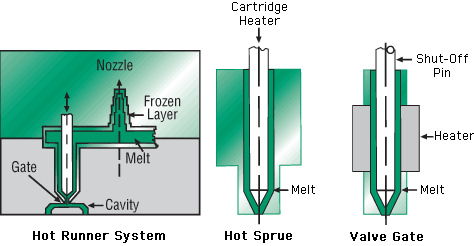Thermoplastic Elastomer Molding Guidelines:
Overmolding Design Considerations
The hot runner design should be balanced for even flow throughout the runner system. Externally heated manifolds work the best for RTP TPE materials. Internally heated systems, which use cartridge heaters, are not recommended as they generally have hot spots which could lead to material degradation. All flow channels should be highly polished with radius corners to minimize the possibility of material stagnation. To maintain high shear, low residence times, and provide for self-clearing, the flow channels should have be 0.250 to 0.375 in (6.35 to 9.52 mm) diameter. Balance volume per shot size.
Hot Sprue Usage For Thermoplastic Elastomer Materials
- Can be utilized to reduce scrap in large runner system
- Off-shelf hot sprue commercially available from many suppliers
- Adds no real complexity to runner system design
Benefits
- Improved economics – less scrap
- Faster cycle time – sprue never freezes off
- 20% to 25% lower total cycle time common in >16 cavity systems
- Can be very significant in large (16 or 32 cavity) cold runner systems
- More repeatable pressure to feed runner system
- Lowers part size variation in critical dimension components
Disadvantages
- Higher capital cost
- Typically more time to tune mold in on initial start up
- Must be purged at end of molding shift
- Potential for material degradation (if TPE is over heated)
- Typically higher maintenance cost




